STARK WEEK EPISODE #11: “No myth is written all at once” — Jared White on THE LAST FOUR BOOKS OF SAMPSON STARKWEATHER
For our final textual episode of Stark Week, Jared White takes us a billion years into the future, where creaky American poetballer Sampsonian Starkweathershire has released his final four books, capping over a career of the highest highs and the lowest lows and the crunchiest chicken tenders. Later today we’ll be posting TWO CONTESTS where you’ll have a chance to win your own copy of The First Four Books of Sampson Starkweather. HTMLGIANT fav Unnameable Books in NYC reports that people have been stealing The First Four Books, which you shouldn’t do, but is also kind of cool, right? DON’T STEAL; WIN CONTESTS. STAY TUNED! For now, we turn to Mr. White and the year 2066—or was it 2666?
 Sampson Starkweather died for the fifth time in the year 2066— or was it 2666? Either way he had already nicknamed the year to a more personable, abbreviated 2-6-6, like police scanner code: 2-6-6, year of the singularity. But was it death? Or like words, would Sampson Starkweather live on as the ghost in the machine?
Sampson Starkweather died for the fifth time in the year 2066— or was it 2666? Either way he had already nicknamed the year to a more personable, abbreviated 2-6-6, like police scanner code: 2-6-6, year of the singularity. But was it death? Or like words, would Sampson Starkweather live on as the ghost in the machine?
Famously, Starkweather’s poetry was entirely written in a blaze during a six-year period before he reached the age of 21, at which point he abandoned writing entirely. Instead he devoted himself to long travels in the southern hemisphere as an incognito adventurer, knight errant, part-time athlete, wrestler, and stone quarry foreman. Whether he died of bodily injuries or illness or returned from his self-imposed exile a much-changed man, he was never seen from again, except in photographs and emails, traveling through the ether more slowly than the news of his death.
Then, during the war, three soldiers are said to have come to the house where Sampson Starkweather was living in the woods alone. Either because of his political beliefs or perhaps in spite of them, he was arrested without charges and executed in a field in front of the Great Fountain on the road between Viznar and Alfacar. But in outer space there are no fountains and no fields; instead there are small space-crafts and plenty of space-junk that must be steered around and so there are also frequent accidents like the one that took place in the tunnel where spaceman Sampson Starkweather was struck in the middle of the night. (What is night in between stars? In outer space is there star weather?).
 His injuries at first appeared minor but in the wake of the incident his drinking became more acute. Shortly after his fortieth birthday he was found in a stupor in the stairwell of his apartment and brought to the hospital. Here, Starkweather drifted in and out of consciousness before expiring. His last words were, “My first four books did this to me.” And by some great coincidence, just down the hall on the same floor, a forty-six year old Sampson Starkweather was admitted almost simultaneously. His chief complaint was hiccups, but it was clear that what ailed him was serious and his condition worsened over the days that followed.
His injuries at first appeared minor but in the wake of the incident his drinking became more acute. Shortly after his fortieth birthday he was found in a stupor in the stairwell of his apartment and brought to the hospital. Here, Starkweather drifted in and out of consciousness before expiring. His last words were, “My first four books did this to me.” And by some great coincidence, just down the hall on the same floor, a forty-six year old Sampson Starkweather was admitted almost simultaneously. His chief complaint was hiccups, but it was clear that what ailed him was serious and his condition worsened over the days that followed.
“Malaria?” one intrepid doctor offered, though there was no consensus. Within days, Starkweather was dead and his publishers began the long work of preparing the unfinished text of his First Four Books to be published posthumously.
Overhead, Sampson Starkweather read these books on the screen of his transom-window, writing in steam with his fingers on the glass with its fogged vantage of Mars. No myth is written all at once. And then, of course, the singularity, much delayed, in that year of sixes, when the upload was complete and the mind inside the machine became indistinguishable from the image of the body outside. (The heart in the machine is green too.)
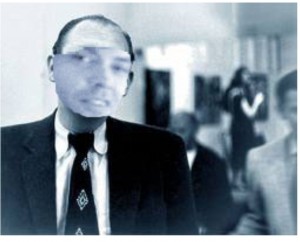 Sampson Starkweather may still be in there, if there can be called an inside, now that time has stopped and the same year continues day after day, a permanent Tron grid of ‘80s video games stretching out into infinity: “Forget futurism… I want to talk to you without skin.”
Sampson Starkweather may still be in there, if there can be called an inside, now that time has stopped and the same year continues day after day, a permanent Tron grid of ‘80s video games stretching out into infinity: “Forget futurism… I want to talk to you without skin.”
Sampson Starkweather is Sampson Starkweather’s ghost, dying. But when a ghost dies, what happens then? When a ghost dies does it come back to life?
Jared White’s most recent chapbook, THIS IS WHAT IT IS LIKE TO BE LOVED BY ME, was published by Bloof Books this spring and is now available as an ebook here, here, or here. Another chap, MY FORMER POLITICS, is forthcoming from H-NGM-N. In addition to writing, he is co-owner of Berl’s Brooklyn Poetry Shop, a small press bookstore, and father of Roman Field White, a seven-month-old baby. READ MORE >
STARK WEEK EPISODE #10: “So of course I said yesh of courth” — Sommer Browning on the cover of SELF HELP POEMS
For our last cover artist divulgence of STARK WEEK, here at mighty mighty Episode Ten, we have the top-of-the-mountain comic drawer and comic speaker and deep poet Sommer Browning to share with us her process for the cover of Self Help Poems and her ideas on what exactly will help us all.
 I was honored (drinking) when Sampson asked me to draw the cover for Self Help Poems, so of course I said yesh of courth. After reading the manuscript, I could see why he asked me to draw this particular cover. The poems pull innocence and nostalgia through the streets of pop culture and childhood—and I think I draw like that. He offered me a few wonderful ideas and I pulled together the ones I loved. One of the ideas was the classic self help book cover, so I researched (Googled) what those look like.
I was honored (drinking) when Sampson asked me to draw the cover for Self Help Poems, so of course I said yesh of courth. After reading the manuscript, I could see why he asked me to draw this particular cover. The poems pull innocence and nostalgia through the streets of pop culture and childhood—and I think I draw like that. He offered me a few wonderful ideas and I pulled together the ones I loved. One of the ideas was the classic self help book cover, so I researched (Googled) what those look like.
I used to work at Waldenbooks (a store that sold textual materials) and the self help section was my favorite (more favorites: Four Loco and images of nuclear reactors). The life-affirming promises on the covers of these books are self-satisfied propaganda at the expense of the self-centered (woman-moms, man-dads, etc.). To me, putting these kinds of promises on the cover of a book of poems was hilarious (Mr. Bean when you are seven years old) and true (Bible)—and I thought it created an interesting juxtaposition (Ice-T & Coco).
Sam also gave me a photograph of himself dressed like Les Nessman in a neck brace waiting for a call from Brian Dennehy. Needless to say, this was pure inspiration. The “Over 7 Sold” sticker was a creative way to conceal a number of things. Pretty much my favorite part of this drawing was Dan Boehl’s suggestion that I add the “*Neck Brace Sold Separately” bit.
I was also in love with spelling the title of the book wrong. So I had a backup cover, a very lo-fi drawing of a fast food type cup with SELP HELF written on it.
Sommer Browning is the author of Either Way I’m Celebrating (Birds, LLC; 2011), a collection of poems and comics, The Presidents (And Other Jokes) (Future Tense Books, 2013), and various chapbooks. With Julia Cohen she runs the Bad Shadow Affair, a reading series in Denver, and with Tony Mancus she founded Flying Guillotine Press, a small poetry chapbook press.
STARK WEEK EPISODE #9: “Help and Hope in Sampson Starkweather’s Self Help Poems” — Amy Lawless on the last book of TFFBOSS
Sniffingly we are nearing the end of STARK WEEK, as we round the corner into the last book, Self Help Poems, with the fantastic Amy Lawless onboard to epically investigate. Don’t put your boots away yet because there is more to come, including prophecy, art talk, videos, and contests!
 I have asked myself many times why actor Mickey Rourke is so appealing and attractive to me. Over time he has aged, yet he still manages to allow us, the consumers, access to another human place and plane. Sampson Starkweather doesn’t use the words “appealing” or “attractive,” but he writes on how Rourke’s “therapist told him he was in a hopeless situation, but he still had hope. All humans aspire to the condition of Mickey Rourke” (255). Here on the ninth page of Self Help Poems in The First Four Books of Sampson Starkweather, hope emerges, which makes sense because man is a social animal—we are each other’s only chance of salvation.
I have asked myself many times why actor Mickey Rourke is so appealing and attractive to me. Over time he has aged, yet he still manages to allow us, the consumers, access to another human place and plane. Sampson Starkweather doesn’t use the words “appealing” or “attractive,” but he writes on how Rourke’s “therapist told him he was in a hopeless situation, but he still had hope. All humans aspire to the condition of Mickey Rourke” (255). Here on the ninth page of Self Help Poems in The First Four Books of Sampson Starkweather, hope emerges, which makes sense because man is a social animal—we are each other’s only chance of salvation.
Mickey Rourke is not tricky; he is wise—body-wise. In the film The Wrestler, viewers followed him into an oblivion, a place we all go (some of us more quickly than others). Some of us are tiptoeing as slowly as possible toward death with our many fish oil supplements, mountain poses, punitive juice cleanses, hand sanitizers, Deepak Chopra books, or prayers. Some of us are in a speeding car wearing no sunscreen, driving as far away from prostate checks as possible, pumping the speedometer far right with a recklessness our mothers should never know exists. We are each Mickey Rourke jumping off the rope toward our own single finality. READ MORE >
July 19th, 2013 / 4:06 pm
STARK WEEK EPISODE #8: “SAM FLIES TO MIDDLE EARTH AND MATES WITH A SPHNIX” — Jonathan Marshall on the cover of THE WATERS

For Episode Great Eight of STAAAAAAAAAAAAAAAAAAAAAAAHK WEEK, we welcome artist and witty flowchartist extraordinaire Jonathan Marhsall to map the process of developing the cover of The Waters, book 3 of The First Four Books of Sampson Starkweather. More multimedia and interaction coming soon! Including contests to win a copy of this bad boy for yourself!
CLICK THE IMAGE TO SEE IT FULL SIZED

Jonathan Marshall is a visual artist living in New York City, originally from Austin, TX.
He is currently holed up in his studio, preparing for a solo exhibition at Grimm Gallery in Amsterdam, NL, which will open in October of 2013. http://www.jonathanmarshall.
July 19th, 2013 / 12:31 pm
STARK WEEK EPISODE #7: “Reveling in the evocative power … of personalized Jabberwocky” — Elisa Gabbert on THE WATERS

For Episode Lucky Seven of STARVING WEEK IT’S STARK STARVED OUT THERE WEAKLINGS, we feature poet mover and shaker Elisa Gabbert on The Waters, book three of The First Four Books of Sampson Starkweather. Read on as EG takes a delightful comb to Starkweather’s transcontemporatory faithfulness.
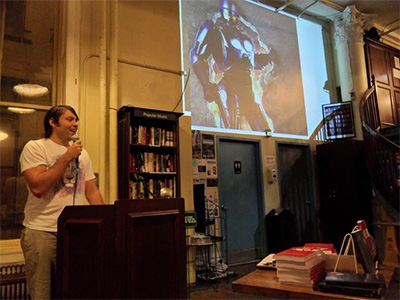 If you don’t speak Spanish, here’s what you need to know about Cesar Vallejo’s Trilce: Clayton Eshleman does the best translations, and Sampson Starkweather does the best transcomtemporations. That’s what he calls them in “The Waters,” Book III of The First 4 Books of Sampson Starkweather – English-to-English translations that update the vocab and bric-a-brac of Vallejo’s originals for the life of an American man straddling the 20th and 21st centuries. In other words, “A transcontemporation is to a poem what RoboCop is to a normal police officer.”
If you don’t speak Spanish, here’s what you need to know about Cesar Vallejo’s Trilce: Clayton Eshleman does the best translations, and Sampson Starkweather does the best transcomtemporations. That’s what he calls them in “The Waters,” Book III of The First 4 Books of Sampson Starkweather – English-to-English translations that update the vocab and bric-a-brac of Vallejo’s originals for the life of an American man straddling the 20th and 21st centuries. In other words, “A transcontemporation is to a poem what RoboCop is to a normal police officer.”
You don’t have to read “The Waters” side by side with Trilce to enjoy it, but doing so makes Starkweather’s tricky, allusive, funny-sad poems extra-magical. Let’s take a look at “XIII” from Trilce, first in Vallejo’s original Spanish:
XIII
Pienso en tu sexo.
Simplificado el Corazon, pienso en tu sexo,
ante el hijar maduro del dia.
Palpo el boton de dicha, esta en sazon.
Y muere un sentimiento antiguo
degenerado en seso.
Pienso en tu sexo, surco mas prolific
y armonioso que el vientre de la Sombra,
aunque la Muerte concibe y pare
de Dios mismo.
Oh Conciencia,
pienso, si, en el broto libre
que goza donde quierre, donde puede.
Oh, escandalo de miel de los crepusculos.
Oh estruendo mudo.
Odumodneurtse!
Now here’s Eshleman’s translation:
XIII
I think about your sex.
My heart simplified, I think about your sex,
before the ripe daughterloin of day.
I touch the bud of joy, it is in season.
And an ancient sentiment dies
degenerated into brains.
I think about your sex, furrow more prolific
and harmonious than the belly of the Shadow,
though Death conceives and bears
from God himself.
Oh Conscience,
I am thinking, yes, about the free beast
who takes pleasure where he wants, where he can.
Oh, scandal of the honey of twilights.
Oh mute thunder.
Rednuhtetum!
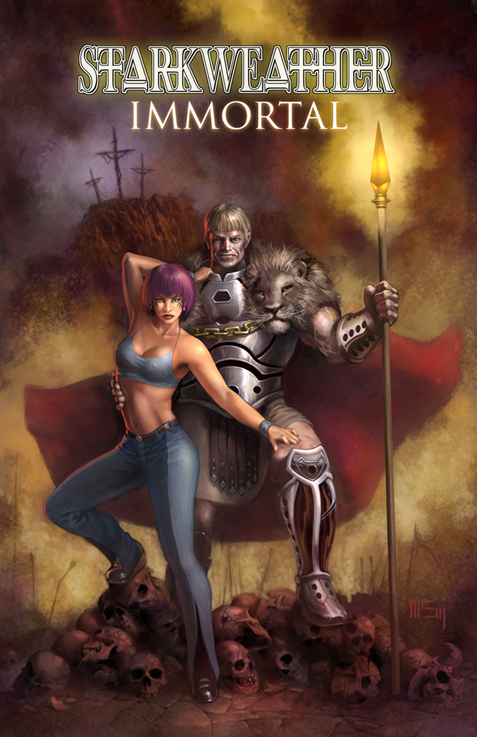 Every translation makes choices, but you can probably see, if you know even a little Spanish, that this is a faithful translation. The final line is the weirdest part of the poem—at first it looks like a nonsense word, then you realize “Odumodneurtse” contains the last two words of the penultimate line, backwards and jammed together to form a new word. Unfortunately, something is lost in Eshleman’s translation—his own nonsense word, “Rednuhtetum,” is “mute thunder” backwards, so the move comes across on a literal level. But in Spanish, the final “o” at the end of “mudo,” for “mute,” echoes the vocative/exclamatory “Oh” at the beginning of the previous two lines. Eshleman’s translated nonsense doesn’t have quite the same effect.
Every translation makes choices, but you can probably see, if you know even a little Spanish, that this is a faithful translation. The final line is the weirdest part of the poem—at first it looks like a nonsense word, then you realize “Odumodneurtse” contains the last two words of the penultimate line, backwards and jammed together to form a new word. Unfortunately, something is lost in Eshleman’s translation—his own nonsense word, “Rednuhtetum,” is “mute thunder” backwards, so the move comes across on a literal level. But in Spanish, the final “o” at the end of “mudo,” for “mute,” echoes the vocative/exclamatory “Oh” at the beginning of the previous two lines. Eshleman’s translated nonsense doesn’t have quite the same effect.
Starkweather’s version isn’t so faithful, especially when it comes to the last line:
XIII
I think of your sex.
With dumbed-down heart I think of your sex
as ants hijack the day’s blonde daughter.
Even the Pope gets the hiccups.
The cardinal fluttering against the glass:
phoenix, arrested.
I think of your sex, wave which knocks
out the breath, holds a body under, no way to say
which way is up. Death keeps feeding coins
into the meter of your mouth.
O, Consequence,
I am thinking too, about you, free animal
who takes pleasure where she wants, because she can.
O, honey of daughterless dusk.
O, hoarse voice of lightning.
Rudderowstarkweathersampson!
You’ll notice that the “transcontemporation” is derived from both the sound of the original lines as well as the meaning, so line three (“ante el hijar maduro del dia”) is a combination of straight translation (“before the ripe daughterloin of day”) and soundplay: ante becomes ants and hijar becomes hijack, but the day’s daughter comes from the “underpoem,” such as that exists, not the surface sounds. And yet, also, some of the poem is entirely new—“phoenix, arrested” seems to come from nowhere, or rather from Sampson’s degenerate brain entirely.
The last line is where you really see the exuberant beauty of Starkweather’s riffs. “Rudderowstarkweathersampson” isn’t anything spelled backwards – it’s his name rearranged. Rudderow (the poet’s middle name) seems to have been triggered by alliterative association with “Rednuhtetum,” Eshleman’s rendition of “mute thunder.” Though the literal meaning of “Odumodneurtse,” such as there is one, is lost in the Starkweather version, it retains that feeling of reveling in the evocative power of nonsense, of personalized Jabberwocky. (Later, in LXV, we learn that Rudderow is “a nonsense word made up by [his] mom.”) And – the really lovely part – Rudderow contains a syllabic “O.”
Then, of course, there are the metaphors both more subtle (I love “wave which knocks / out the breath, holds a body under, no way to say / which way is up” – though a wave of love is less strange than a prolific furrow) and more absurd (“Death keeps feeding coins / into the meter of your mouth”) than the original. Every poem in “The Waters” is like this, not a puzzle to figure out, but a little game full of meanings, as many as you want: “at the edge / of beauty, it quivers, it sings, it holds / no water.”
Elisa Gabbert is the author of The Self Unstable (forthcoming from Black Ocean in Fall 2013) and The French Exit (Birds LLC, 2010). Her poetry, prose, and collaborations have appeared widely in publications such as Boston Review, Colorado Review, Conduit, Denver Quarterly, Pleaides, and elsewhere. She is a founding member of the Denver Poets’ Theatre and blogs at http://thefrenchexit.blogspot.com/.
STARK WEEK EPISODE #6: “A few days later Sam called to wake me in the middle of the night to tell me about his Galaga high score at a bar and that the game reminded him of the poems in the book.” — Eric Amling on the cover of LA LA LA

For Episode Six of STARKING IT’S STARKING EVERYBODY SPARKING week, poet and collagist and GQ cucumber Eric Amling answers some questions about working on the LA LA LA cover. Eric Amling is one of our favorite cover artists here at HTMLGIANT (or at least one of Mike’s favorites), so we are very pleased to get a peek into his mustachioed brain!
 1.) What was your experience working on the cover of LA LA LA?
1.) What was your experience working on the cover of LA LA LA?
Witnessing a sandwich of friendship and professionalism produce a satiating item.
2.) What was your process (how did you come up with the idea)?
When Sam and I first started talking about the LA LA LA poems we gravitated towards descriptions with a sensation of falling. So I went home and started some different approaches to the cover. A few days later Sam called to wake me in the middle of the night to tell me about his Galaga high score at a bar and that the game reminded him of the poems in the book. I recalled an image I recently cut from the cover of a Limousine and Chauffeur magazine circa early 80s. I thought it brought the digital aspect and feeling of motion with simplicity. Luckily, Sam agreed.
3.) Any stories/anecdotes?
I’m an adult male that occasionally moonlights in the act of collage.
4.) How did your cover relate to your reading the book (or the books content/poetry)?
I approached the LA LA LA book as a separate entity. I imagined finding an original limited edition in an upstate library of a dead city ex-patriot. An old looking book about the future. Assuming I read the book I think this is accurate.
5.) How did your work for this cover relate to your other work as an artist?
As an artist I’d have to say this cover was a departure for me, or rather, an exercise in restraint. I have a tendency to overthink my collages and my cover designs. And I enjoyed using one element of what later became part of a collage as the sole description of the book. I tend to admire most the artist that can show that restraint. To put it another way; it was different because it didn’t have a bunch of colors and asses in it like my other work.
 5.) What is your relationship with Sampson, what was it like to work with him? Tell us one story about him?
5.) What is your relationship with Sampson, what was it like to work with him? Tell us one story about him?
Sam and I are friends and neighbors. Our relationship began with our mutual interest in poetry and has been maintained through drinking and sports. His work and email ethics are sound but he can be unreliable with the phone at times.
I may have my time and events wrong but I remember bringing a dear friend of mine to a reading Sam was doing in Brooklyn. Someplace nicer. The Montauk Club, maybe. She is a person who had issues with poetry. Mainly, poets and poetry readings, understandably. I remember Sam particularly nailed it that night. She was moved, entertained and charmed by Sam’s work. I was proud of Sam for that and it shows the reach his poetry can have. His passion for poetry is obvious but it takes more than that to affect people and he accomplishes that.
6.) Do you have any rough drafts, or covers you didn’t use?
I have three, maybe four, other drafts. If any diehard fans are really interested I can send them a file. [Editor’s note: Eric Amling disappeared shortly after this interview was conducted, but we found him later at unrelated blimp party, where he was patiently explaining to the gentleman “piloting” the blimp that the cigar he was smoking was not, in fact, endangering the flight but was rather supplementing its propulsion. We approached him and enthused that STARK WEEK was only, in fact, for diehard fans, and could he please produce those files? Amling, a real matador’s matador, happily obliged. The results are after the jump.]
STARK WEEK EPISODE #5: “the world can’t / hold / what is / the world / built for / exactly” — Melissa Broder on Starkweather’s LA LA LA

For Episode Five of STARK ATTACK A WEEK OF STARK ATTACKS, we move onto the second book of T4B with the firm and jubilant columns and poemreview joy of our own Melissa Broder talking about Sam’s LA LA LA. As an added bonus, we also get the last LA LA LA itself to accompany Melissa’s text!
 Joyce Carol Oates
Joyce Carol Oates
or someone
said don’t
put yourself
in the review
fuck that
even if
I wanted to
disappear
WHICH I DO
there is no
omniscient god
of reviewership
only the white goddess
and the poet
and a pair of eyes
trying to jump
‘if you love me
unlock your phone
see those two lights
on the sea
that’s me
that’s me
that’s me’
some people
you just know
will be ok
Sampson
Starkweather
the poet
is one
he says
his desire map
is running
out of room
mine is more
an ash mouth
either way
the world can’t
hold
what is
the world
built for
exactly
‘the more animal
the less pain…
stagger to the edge
of the woods
suck the poison out’
I have had
to rescue
myself
from the earth
and rescue
myself
from the ways
I rescued
myself
1000000 times
nobody gets
what they want
why not?
green paper
or something
something
‘blood on the keyboard
spiritual pop ups
dizzy by
bright lipstick’
I want to
disappear
but really
I want to stay
‘past black fields
that feel more
like memory
than memory can…
this life is super
fucking hard’
when you get
to the sky
there’s a sky
let me float
twice
once so
that I know
once so
I remember
Melissa Broder is the author of two collections of poems, most recently MEAT HEART (Publishing Genius, 2012). Poems appear or are forthcoming in The Iowa Review, FENCE, Guernica, The Missouri Review, et al.
LA LA LA EXCERPT BELOW THE JUMP!
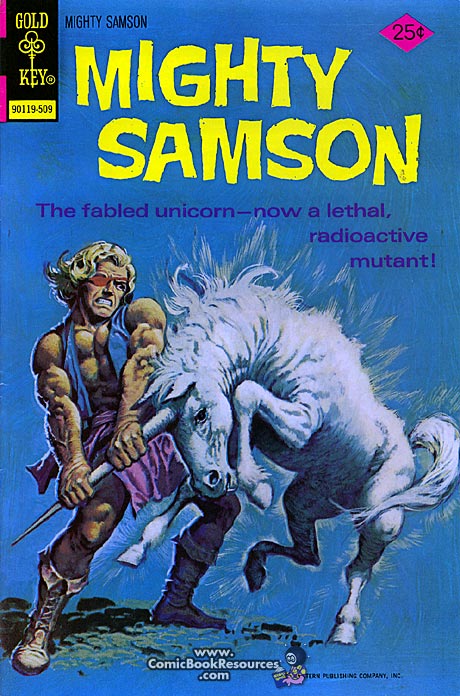
July 17th, 2013 / 3:02 pm
STARK WEEK EPISODE #4: “I saw a small boy on a great precipice” — Bianca Stone on the cover of King of the Forest

For Episode Four of Stark Week, Bianca Stone answers some questions about working with the forest king Sampson Starkweather for the triumphant cover of King of the Forest!
 1) What was your experience working with Sampson?
1) What was your experience working with Sampson?
Joy. It was like working with a doting older brother.
2) What was your process (how did you come up with the idea)?
I had just illustrated the Birds LLC book by Ana Bozicevic, Rise in the Fall, and I’d been wrapped up in the idea of the cavalier, the knight. Her book felt like an army charging over a hill. It was always the Joan of Arc figure I pictured with her book. I’d done drawings of knights in armor, looking at a pamphlet my fiancé’s father gave me on armor at the Metropolitan Museum of Art, which has always been one of my favorite things to see there. Obviously they were so insanely masculine. I couldn’t fit many of them into the tone of Ana’s book.
Luckily, I opened Sampson’s book King of the Forest. The knights charged up, offering themselves. But they too seemed too masculine for his book. I say this because the poems had the voice of a young boy, whose vivid imagination was tangible.
Rather than faceless, colossal suits of armor, I saw a small boy on a great precipice. One whose power was great, but who was afraid and isolated.
The artwork I did for Sampson was inspired by the cover of Ted Hughes’s The Iron Man. Which Sampson really loves. And so do I.

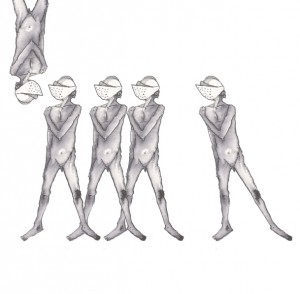
Dark contrasts and cross hatching….I’m already there.
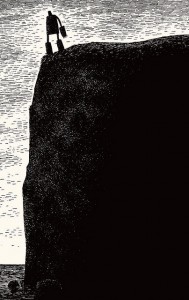
Actually before we were friends we read together, and I remember him telling poop jokes. Or was it a poop poem? He had a chapbook called City of Moths and I bought it! My mom was there and saved the flier with our pics and bios. It’s hanging in the bathroom at her house, and when I was home last time, I noticed him on there! I had never made the connection in my mind.
 Sampson and I are close friends. I love every time I get to collaborate with him because he’s so goddamn energetic. He’s one of the most dedicated, hard working poets I’ve ever met. While it might feel sometimes like your opinion isn’t filtering through his buoyant, manic stream of awesomeness… it is. He listens and takes everything in. He has a very generous heart and he’s a fucking fabulous poet.
Sampson and I are close friends. I love every time I get to collaborate with him because he’s so goddamn energetic. He’s one of the most dedicated, hard working poets I’ve ever met. While it might feel sometimes like your opinion isn’t filtering through his buoyant, manic stream of awesomeness… it is. He listens and takes everything in. He has a very generous heart and he’s a fucking fabulous poet.
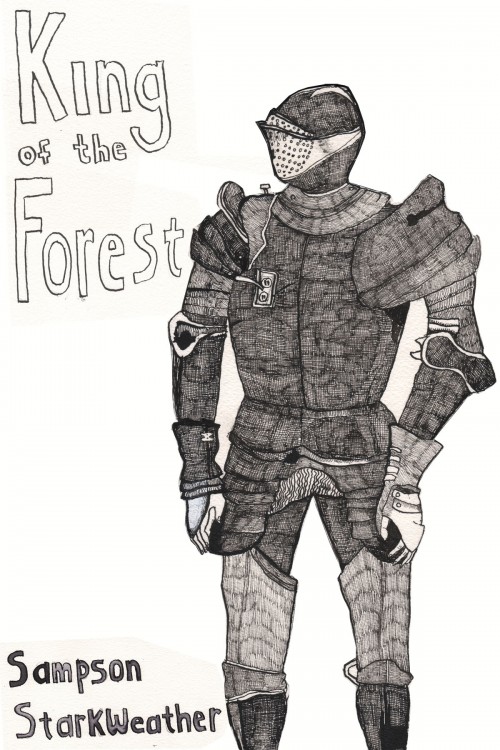
Bianca Stone is a poet and visual artist. She is the author of several chapbooks and the poetry-comic I Want To Open The Mouth God Gave You, Beautiful Mutant (Factory Hollow Press), the editor of Monk Books, and a regular contributor for The The Poetry Blog. Her poems have appeared in Best American Poetry 2011, Conduit, Crazyhorse, and Tin House. Stone collaborated with Anne Carson on Antigonick (2012), a new kind of comic book and translation. She lives in Brooklyn with her boyfriend, poet Ben Pease, and their cat. For more information, check out her page at the Poetry Foundation.
STARK WEEK EPISODE #2: “Off the Top Rope” — Matt Bollinger on collaboration with Sampson Starkweather

For Episode Two of STARK WEEK, we hear from Matt Bollinger, who designed and drew the front and back covers of The First Four Books of Sampson Starkweather.


 Sampson wrote to me early last December to ask if I would make a cover for his book. “I’m very busy,” I summarily replied but in less summary and more polite terms. Because of a new full-time teaching job and an impending solo exhibition, I felt there was no way I would possibly have the time to make a cover. The next email I received from him came like a sudden summer storm (particularly strange in the final week of a wintering semester) complete with simultaneous heavy raindrops and sunshine. He supplied approximately 43 ideas for the cover, including examples from the history of fantastic poetry covers. Here’s an example:
Sampson wrote to me early last December to ask if I would make a cover for his book. “I’m very busy,” I summarily replied but in less summary and more polite terms. Because of a new full-time teaching job and an impending solo exhibition, I felt there was no way I would possibly have the time to make a cover. The next email I received from him came like a sudden summer storm (particularly strange in the final week of a wintering semester) complete with simultaneous heavy raindrops and sunshine. He supplied approximately 43 ideas for the cover, including examples from the history of fantastic poetry covers. Here’s an example:
“A note about Andre the Giant off the top rope: this is actually an image that doesn’t exist, which is why it’s appealing to me, the unknown, what only lives in the imagination…so to my knowledge, Andre the Giant has never jumped from the top rope, but god, how i longed to see that; (i’ll send you the poem about it), but in my imagination, i love the image of the 7’5 almost 600 pound flying through the air Jimmy-Supafly-Snuka-style, althought i’m thinking the image would only be part of him or his silhouette, or partly his enormous shadow….”
 A few days after the semester ended when I was in rural Illinois staying in the log cabin where my fiancé grew up, I found myself making numerous studies for the cover. It seemed that I was going to design the thing after all. Sampson, like his neck-brace wearing alter ego from the sectional cover of Self Help Poems, is impossible to say “no” to. Of course, I realized that I couldn’t possibly have let this chance go by. I felt too much of a kinship with his poetry. In my painting-collages, I grapple with a similar intersection between memories (possibly misremembered) and the present moment; between romantic hopefulness and a self-conscious criticality that withers nostalgia. Sampson puts it well in Self Help Poems:
A few days after the semester ended when I was in rural Illinois staying in the log cabin where my fiancé grew up, I found myself making numerous studies for the cover. It seemed that I was going to design the thing after all. Sampson, like his neck-brace wearing alter ego from the sectional cover of Self Help Poems, is impossible to say “no” to. Of course, I realized that I couldn’t possibly have let this chance go by. I felt too much of a kinship with his poetry. In my painting-collages, I grapple with a similar intersection between memories (possibly misremembered) and the present moment; between romantic hopefulness and a self-conscious criticality that withers nostalgia. Sampson puts it well in Self Help Poems:
Nintendo always felt more real than life. Simple yet somehow beautiful worlds, constantly breaking down, designed, whether intended or not, as pixilated avatars of hope. Old school video games are perfect precisely because of how unreal they are. They don’t try to teach you anything, except if you see a hammer, you better grab it.
The process of designing the cover was definitely collaborative. In my recent exhibition at Zürcher Studio in New York, I collaborated with a number of poets, Farrah Field, Alina Gregorian, Steven Karl, and Paige Taggart, who supplied texts for collages I made that depicted notebooks (Dan Magers handled the editing process). This project readied me for the onslaught of fantastic ideas that Sampson and I power-spiked back and forth (not unlike a twisted game of dodge ball where the only defense against the red rubber ball hurtling at face-bash speed is to slam it with your best haymaker).
When developing the images for the front and back covers, Sampson and I discussed Andre the Giant, Louis Zukofsky, “guerrilla underground hand-drawn poetry press style”, LARPing, Nintendo and Mickey Rourke among other things. Sampson had become obsessed with both the coat of arms and a large number 4 modeled after the “A” on Zukofsky’s famous cover. While we tried out a number of variations (see below), we went with the big 4 on the front and the coat of arms on the back.
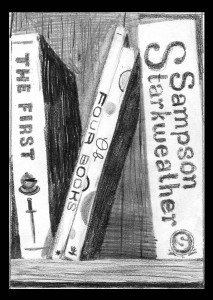
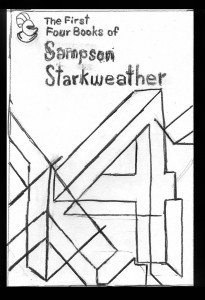

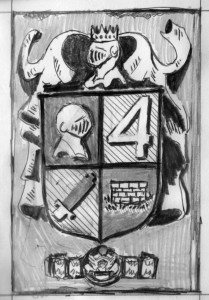
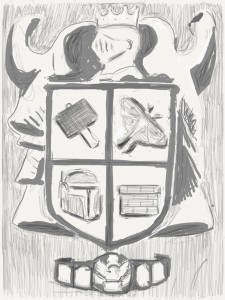 I had the idea that the coat of arms should spawn from the inner selves of the various personas in his books and arrived at the hobo-TV-fire, the well (Sampson’s idea), the butterfly, and the grabbable hammer mentioned above. We hoped that his cover would resemble an older generation of much coveted books, the sort grabbed hungrily and pressed to the chest in basement bookstores or, more likely, found wrapped in a banana leaf on the shore of a distant island, the same far-away shore where you might find yourself 300 years in the future founding a religion who worships that sacred number: 4.
I had the idea that the coat of arms should spawn from the inner selves of the various personas in his books and arrived at the hobo-TV-fire, the well (Sampson’s idea), the butterfly, and the grabbable hammer mentioned above. We hoped that his cover would resemble an older generation of much coveted books, the sort grabbed hungrily and pressed to the chest in basement bookstores or, more likely, found wrapped in a banana leaf on the shore of a distant island, the same far-away shore where you might find yourself 300 years in the future founding a religion who worships that sacred number: 4.
Matt Bollinger is an artist who lives in Peekskill, NY. He has exhibited extensively in the U.S. and France. In March 2013, he had his most recent solo show, Bed on the Floor, at Zürcher Studio in NYC. His work has appeared in the New Yorker and has been written about in Le Monde, Elephant Magazine, Anthem Magazine, and elsewhere. He is represented by Zürcher Studio, New York, NY. www.mattbollinger.com



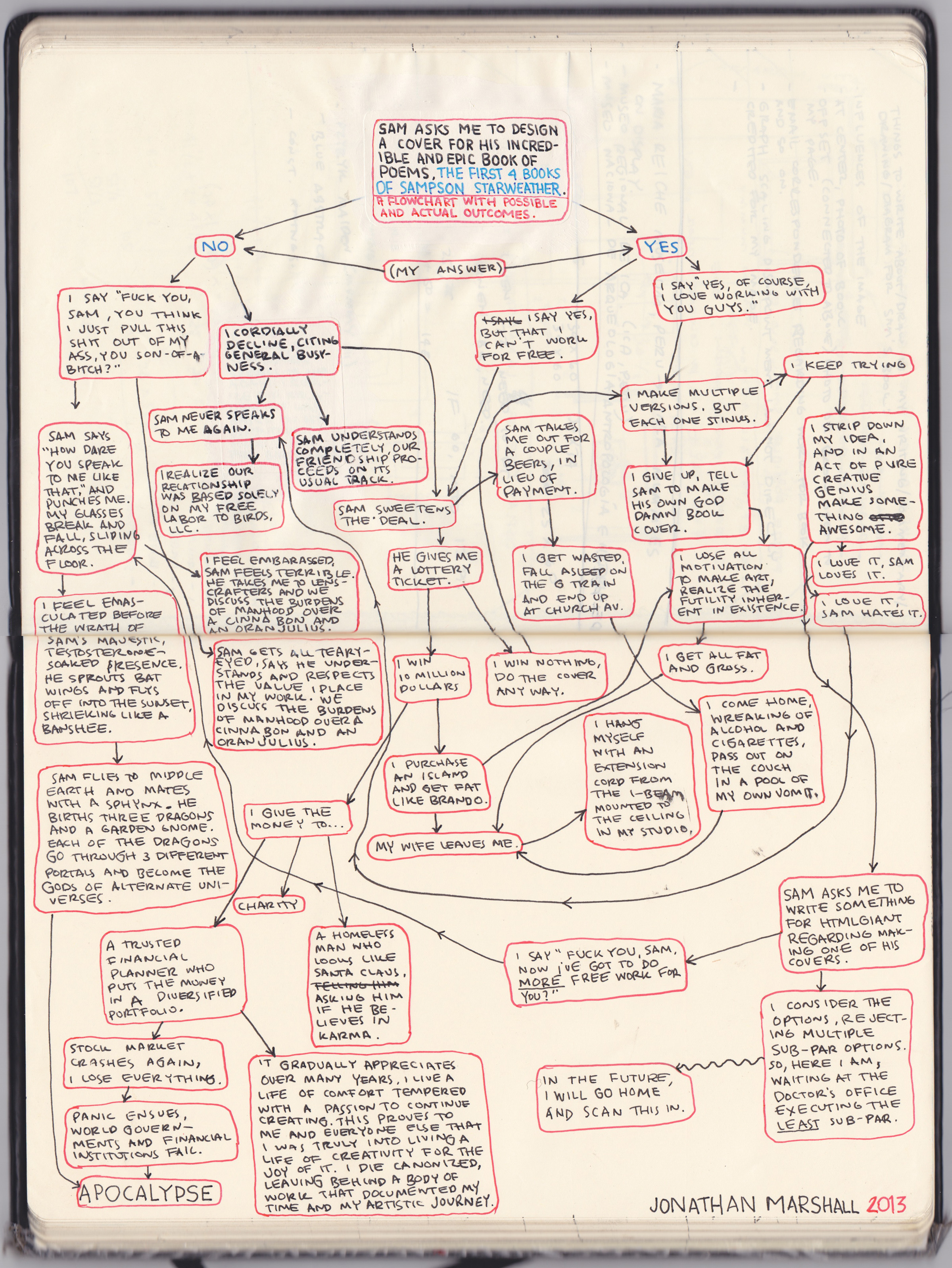

 But these lines don’t believe in themselves. Or do they? When Obama is elected, the poet is astounded because “it had nothing to do with politics or humanity or any of that shit, it was simply the fact that language did this.” Hope is the last word in the book, books. On the other hand:
But these lines don’t believe in themselves. Or do they? When Obama is elected, the poet is astounded because “it had nothing to do with politics or humanity or any of that shit, it was simply the fact that language did this.” Hope is the last word in the book, books. On the other hand: